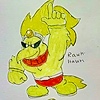HOME | DD
 Eurwentala — Archaeotherium
Eurwentala — Archaeotherium

#archaeotherium #fossil #mammal #oligocene #entelodont #prehistoric
Published: 2017-09-18 19:12:28 +0000 UTC; Views: 7619; Favourites: 261; Downloads: 0
Redirect to original
Description
Lately, I've been fascinated with entelodonts. Once nicknamed "terminator pigs", phylogenies imply they might actually be more closely related to hippos and whales. "Terminator hippo" sounds like a tautology, given the temperament and dangerousness of the living hippopotamus.In this reconstruction of Archaeotherium, I tried giving the animal some similarity to hippos while also depicting it as fully terrestrial, competent hunter. This cow-sized animal seems to have eaten early rhinos and chalicotheres (as shown by bite marks in bones and even one series of fossil footprints preserving a chase) and small camelids, which one individual apparently bit in half and preserved for later use.
Referenced mostly from Witmer Labs wonderful 3D skull that can be seen here: www.ohio.edu/people/witmerl/3D…
Related content
Comments: 25

👍: 0 ⏩: 0

👍: 1 ⏩: 0

Not exactly the prettiest beastie, but under your skilled hands a very charismatic specimen!
👍: 0 ⏩: 1

Nice to see something new from you! Something resembling a hippo a bit makes most sense looking at the head.
👍: 0 ⏩: 1

"...and small camelids, which one individual apparently bit in half and preserved for later use." - is there any source of this case?
👍: 0 ⏩: 1

The case is mentioned in Darren Naish's blog post here: blogs.scientificamerican.com/t… and the original citation is 'Sundell, K. A. 1999. Taphonomy of a multiple Poebrotherium kill site – an Archaeotherium meat cache. Journal of Vertebrate Paleontology 19 (Supp. 3), 79A.'
👍: 1 ⏩: 1

Makes sense that the entelodonts would have looked more like terrestrial hippos than like monster pigs.
👍: 0 ⏩: 1

Yeah. Still many peae will still ca these things carnivores pigs regardless.
👍: 1 ⏩: 0

Cheek flanges need more tissue on them
👍: 0 ⏩: 1

I think shrink-wrapping refers to a quite different phenomenom.
"Feathery theropods and fuzzy ornithischians have been portrayed with only the minimal amount of covering such that their skeletal outline is still visible. At its most extreme, this trend has resulted in ‘zombie dinosaurs’ where every bone in the skeleton is visible in the live animal. This method of applying the minimal amount of soft tissue to a reconstruction has become known as shrink-wrapping."
From blogs.scientificamerican.com/t…
In this case, you suggest there's too little soft tissue in one specific region of the animals face, instead of the whole animal depicted as a "zombie".
Anyway, I don't really understand this tissue on the cheek flanges. Why? There's tissue underneath them (you can see their underside is mostly attached to the soft cheek, with just the margins hanging free), but the only thing that would really make sense on top of them would be blubber. There's next to no musculature in there. Blubber doesn't make any sense - this is a cursorial terrestrial animal, not a hippo or a whale, even though it's distantly related. And if they used their flanges in combat or display, what sense would it make for them to be completely covered by soft tissues?
👍: 0 ⏩: 2

If the flanges were used in combat, having some sort of soft tissue on top of them would help cushion the blows.
I don't think your depiction here is shrinkwrapped, though.
👍: 0 ⏩: 1

Possibly, though warthog 'warts', horns and antlers of giraffes, bovids and cervids, and the tusks of elephants are hardly very cushioned. The only hard ornaments cushioned by soft tissue I can think of are the 'internal antlers' of beaked whales - and only because they can still be 'seen' through echolocation. phenomena.nationalgeographic.c…
👍: 1 ⏩: 0

Do we know if they had proper hooves like pigs and ruminants have?
Because camels, the most basal artiodactyls, don't really have true hooves, just a pair of toes. And hippos and whales, entelodonts' closest living relatives, don't have hooves either, most likely as an adaptation for an aquatic lifestyle.
👍: 0 ⏩: 1

I haven't looked into it in detail, but at least most sources seem to state entelodonts had two-toed hooves, being more cursorial than living pigs (which have four toes).
👍: 1 ⏩: 0




















